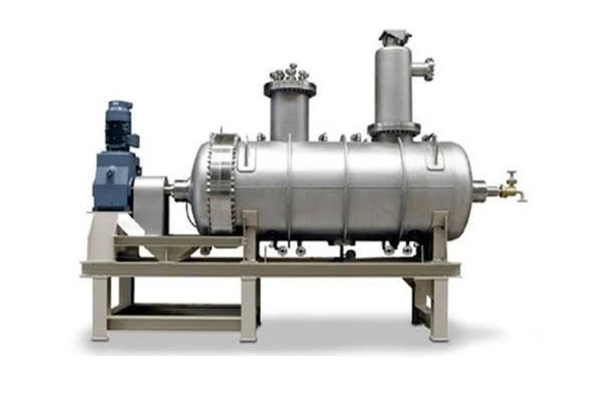WORKING
The machine is with heating jacket, which can heat the materials by hot water, hot oil, steam and other medium. The whole machine is designed as closed type, vacuum system is for option to pump out the air and drain the liquid. In addition, a dust collector, condensing reflux device, solid-gas separator, etc. will be equipped in front of vacuum system to reduce the raw materials consumption.
The device can be divided into single-shaft and dual-shaft model. Various types of agitators are for option, including blade type, ribbon type, plough type, etc.
Ribbon type: The outer ribbon push the materials from inlet end towards the outlet end whereas the inner ribbon push material in reverse direction, different ribbon angle, direction generate different materials flow, therefore the materials get fully mixed.
Plough type: The plough not only disperses materials along axial direction during high speed rotation, but also drives the materials flow in circles around the chamber wall, which settles the stratification efficiently. At the same time, the high speed cutters generate breaking and dispersing effect.
Blade type: Blades arranged in a special angle rotate reversely at the same speed, to ensure the materials are thrown in radial, axial, and circle direction, generate cross circulating, mixing and shearing effect.
CONSTRUCTION AND FUNCTION
A Rotary Vacuum Paddle Dryer Dryer (RVPD) is a cylindrical vessel equipped with a rotating agitator (paddle) that dries materials under vacuum. It's designed for efficient and gentle drying of wet materials, especially those sensitive to high temperatures, by utilizing indirect heat transfer and vacuum to reduce boiling points and accelerate moisture evaporation.
CONSTRUCTION
CYLINDRICAL VESSEL :
The main structure is a fixed, cylindrical shell, often made of stainless steel for corrosion resistance.
ROTATING AGITATOR :
A hollow shaft with paddles attached is the core of the RVPD. These paddles are designed with scraper blades that continuously move and scrape the material against the heated inner surface of the dryer.
HEATING SYSTEM :
A jacket or limpet coil is typically used for external heating, providing indirect heat transfer. The hollow shaft and paddles are also heated internally, further increasing the heat transfer area.
VACUUM SYSTEM :
A vacuum pump, condenser, and receiver are essential components. The vacuum reduces the pressure inside the dryer, lowering the boiling point of the solvent (usually water) and accelerating evaporation.
DRIVE MECHANISM :
A motor, reduction gearbox, and chain sprocket system drive the rotating agitator. These components are designed for reliability and controlled speed.
DISCHARGE VALVE :
A discharge valve allows for easy and complete removal of the dried product.
OPTIONAL COMPONENTS :
Dust catchers, bag filters, and nitrogen purging systems may be included for enhanced safety and process control.
FUNCTION
CHARGING :
The wet material (cake or slurry) is fed into the dryer through a charging door while the agitator is rotating.
HEATING :
Heat is transferred to the material via the jacket or limpet coil and the heated shaft and paddles.
VACUUM APPLICATION :
Vacuum is applied to the dryer, reducing the pressure and lowering the boiling point of the solvent.
DRYING :
As the agitator rotates, it continuously moves and scrapes the material against the heated surfaces, promoting efficient drying.
EVAPORATION AND CONDENSATION :
Evaporated solvent vapors are drawn into the dust catcher, then through the condenser where they condense and are collected in the receiver.
DISCHARGE :
Once the drying process is complete, the dried product is discharged through the valve.
ADVANTAGE
HIGH HEAT TRANSFER :
The rotating paddles and double-wall construction promote efficient heat transfer, maximizing drying performance.
UNIFORM DRYING :
The continuous agitation ensures even drying throughout the batch, preventing over-drying or under-drying.
REDUCED CYCLE TIMES :
RVPDs can significantly reduce drying times compared to conventional dryers, often by 30-50%.
LOW ENERGY CONSUMPTION :
The high differential temperatures and efficient heat transfer contribute to lower energy consumption.
PRODUCT QUALITY AND SAFETY
IDEAL FOR SENSITIVE MATERIALS :
Vacuum drying allows for drying temperature-sensitive materials at lower temperatures, minimizing degradation.
HIGH SOLVENT RECOVERY :
The closed system design enables efficient collection and recovery of solvents.
MINIMAL PRODUCT ENTRAPMENT :
Internal filters help minimize product entrainment under vacuum.
ENHANCED PRODUCT QUALITY :
Low-temperature drying can improve product quality by preserving sensitive ingredients.
CLOSED SYSTEM :
The closed-system design enhances safety for operators and the environment.
